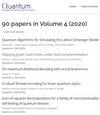(Almost-)Quantum Bell Inequalities and Device-Independent Applications
IF 5.1
2区 物理与天体物理
Q1 PHYSICS, MULTIDISCIPLINARY
引用次数: 0
Abstract
Investigations of the boundary of the quantum correlation set have gained increased attention in recent years. This is done through the derivation of quantum Bell inequalities, which are related to Tsirelson's problem and have significant applications in device-independent (DI) information processing. However, determining quantum Bell inequalities is a notoriously difficult task and only isolated examples are known. In this paper, we present families of (almost-)quantum Bell inequalities and highlight four foundational and DI applications. Firstly, it is known that quantum correlations on the non-signaling boundary are of crucial importance in the task of DI randomness extraction from weak sources. In the practical Bell scenario of two players with two $k$-outcome measurements, we derive quantum Bell inequalities that demonstrate a separation between the quantum boundary and certain portions of the boundaries of the no-signaling polytope of dimension up to $4k-8$, extending previous results from nonlocality distillation and the collapse of communication complexity. Secondly as an immediate by-product, we give a general proof of Aumann’s Agreement theorem for quantum systems as well as the almost-quantum correlations, which implies Aumann’s agreement theorem is a reasonable physical principle in the context of epistemics to pick out both quantum theory and almost-quantum correlations from general no-signaling theories. Thirdly, we present a family of quantum Bell inequalities in the two players with $m$ binary measurements scenarios, that we prove serve to self-test the two-qubit singlet and the corresponding $2m$ measurements. Interestingly, this claim generalizes the result for $m=2$ discovered by Tsirelson-Landau-Masanes and shows an improvement over the state-of-the-art Device-Independent Randomness-Amplification (DIRA). Lastly, we use our quantum Bell inequalities to derive the general form of the principle of no advantage in nonlocal computation, which is an information-theoretic principle that serves to characterize the quantum correlation set.(几乎)量子贝尔不等式和与设备无关的应用
近年来,对量子相关集边界的研究越来越受到关注。量子贝尔不等式与齐雷尔森问题有关,在设备无关(DI)信息处理中有着重要应用。然而,确定量子贝尔不等式是一项众所周知的艰巨任务,目前只知道一些孤立的例子。在本文中,我们介绍了(近)量子贝尔不等式族,并重点介绍了四个基础性和 DI 应用。首先,众所周知,非信号边界上的量子相关性对于从弱信号源中提取 DI 随机性至关重要。在两个参与者有两个 $k$ 结果测量的实际贝尔场景中,我们推导出量子贝尔不等式,证明量子边界与维度高达 $4k-8$ 的无信号多面体边界的某些部分之间存在分离,扩展了之前从非位置性蒸馏和通信复杂性坍缩中得出的结果。其次,作为直接的副产品,我们给出了量子系统以及近量子关联的奥曼一致定理的一般证明,这意味着奥曼一致定理是认识论背景下从一般无信号理论中挑出量子理论和近量子关联的合理物理原理。第三,我们提出了一个量子贝尔不等式族,在两个玩家带$m$二元测量的情况下,我们证明这个不等式族可以自我测试双量子比特单子和相应的$2m$测量。有趣的是,这一主张概括了齐雷尔松-朗道-马萨尼斯发现的 $m=2$ 结果,并显示了对最先进的设备无关随机性放大(DIRA)的改进。最后,我们利用量子贝尔不等式推导出了非局部计算中无优势原理的一般形式,这是一个信息论原理,用于描述量子相关集的特征。
本文章由计算机程序翻译,如有差异,请以英文原文为准。
求助全文
约1分钟内获得全文
求助全文
来源期刊

Quantum
Physics and Astronomy-Physics and Astronomy (miscellaneous)
CiteScore
9.20
自引率
10.90%
发文量
241
审稿时长
16 weeks
期刊介绍:
Quantum is an open-access peer-reviewed journal for quantum science and related fields. Quantum is non-profit and community-run: an effort by researchers and for researchers to make science more open and publishing more transparent and efficient.
 求助内容:
求助内容: 应助结果提醒方式:
应助结果提醒方式:


